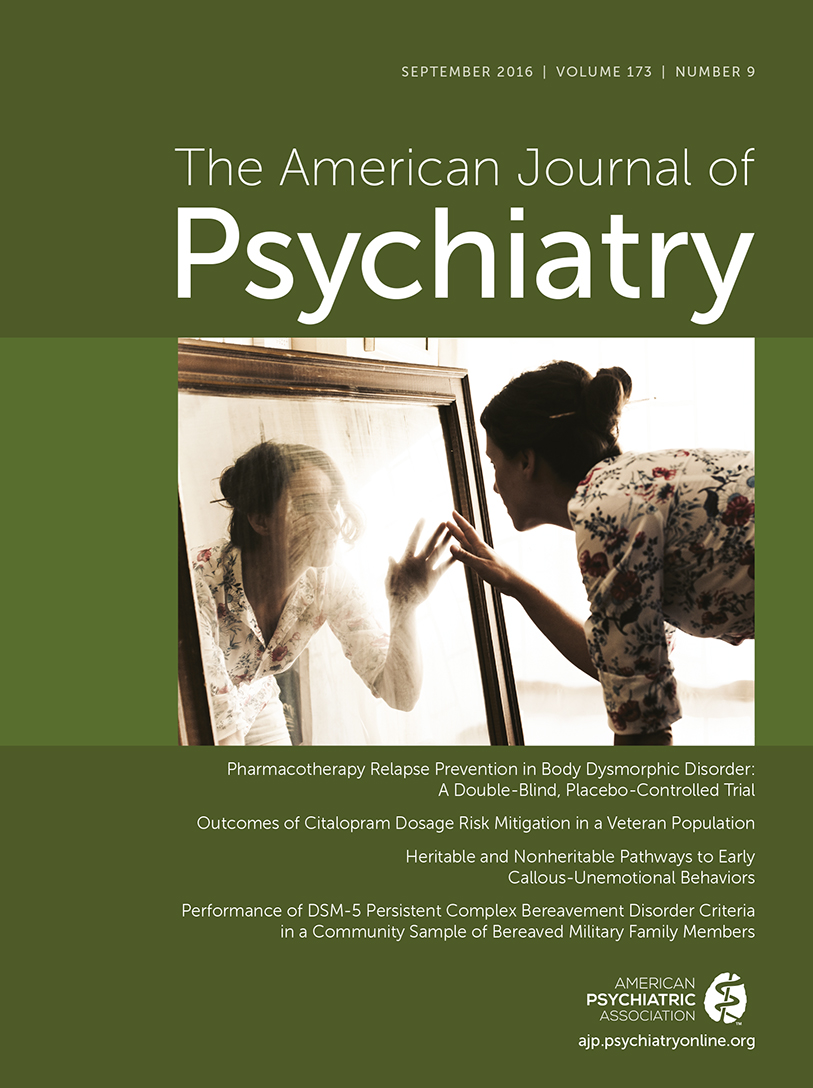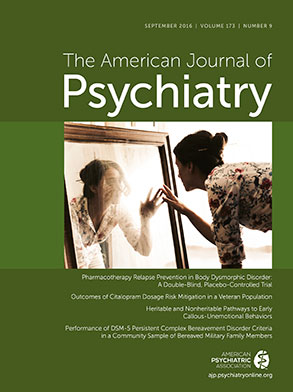The study by Cozza et al. (
1), “Performance of DSM-5 Persistent Complex Bereavement Disorder Criteria in a Community Sample of Bereaved Military Family Members,” represents exactly the kind of research that DSM-5’s Sub-Workgroup on Trauma-/Stress-Related and Dissociative Disorders had hoped for when they placed persistent complex bereavement disorder in DSM-5’s (
2) section III (appendix) as an “emerging diagnosis.”
Clinically significant complications following the death of a loved one have been recognized since 1917, when Freud wrote
Mourning and Melancholia (
3). More recent research has focused on abnormal grief reactions. The challenge in this domain has always been where to draw the line between intense emotional reactions that are a part of the normal human experience versus abnormal, clinically significant bereavement-related problems. Such a distinction has important implications, since normal grief reactions resolve within 6–12 months and usually require little, if any, intervention by mental health professionals. On the other hand, intense bereavement-related reactions that exceed cultural norms and persist for more than a year are generally expected to benefit from psychotherapy, pharmacotherapy, or both.
Investigators studying bereaved individuals who exhibit abnormally intense and persistent grief, severe impairment in daily functioning, and an inability to move forward in life have proposed two specific syndromes: prolonged grief disorder (
4) and complicated grief (
5). Despite much overlap, there are differences between the two. The symptoms of prolonged grief disorder focus on loss of the loved one and separation from the deceased; they are distinguished from normal grief, primarily by their intensity and duration (
4). Complicated grief, however, in addition to very intense and prolonged symptoms of normal grief includes 1) complicating thoughts (such as ruminative thoughts about the death, how the death might have been prevented, and who is to blame); 2) excessive avoidance of thoughts, activities, or situations that arouse grief-related emotions; and 3) ineffective emotion regulation (
5). Therefore, the DSM-5 sub-workgroup was put in a position where two thoughtful groups of rigorous investigators had come up with two overlapping but different conclusions about the best diagnostic criteria for an abnormal grief reaction. There were also some methodological differences in the research published by these two groups, such as different instrumentation and diagnostic thresholds, varied study designs, reliance (sometimes) on convenience samples, varying findings among different populations, different modes of death, and different relationships with the deceased among different participants.
Although the DSM-5 sub-workgroup was very favorably disposed toward adding a new diagnosis addressing abnormal bereavement-related emotions and behavior, they did not believe that they could or should choose between prolonged grief disorder and complicated grief. Furthermore, given the aforementioned methodological concerns and differences, it seemed apparent that more research was needed before data supporting specific diagnostic criteria for a bereavement-related disorder could satisfy DSM-5’s rigorous standards for inclusion of a new diagnosis. As a result, persistent complex bereavement disorder was essentially constructed as an amalgam of all of the symptoms included in either prolonged grief disorder or complicated grief and placed in DSM-5’s section III (
2) as an emerging disorder for two reasons. First, to stimulate new research that would rigorously fill gaps that needed filling before such a diagnosis could be included in the next revision of DSM-5. Second, the sub-workgroup expected that such research would separate those symptoms that needed to be retained from those that either were redundant or should be excluded for other reasons. It was further expected that such research would also obtain the data needed to set specific symptom thresholds for each diagnostic cluster that remained in the persistent complex bereavement disorder construct.
Cozza et al. (
1) have conducted an important study in this regard, comparing the performance of persistent complex bereavement disorder diagnostic criteria with those of both prolonged grief disorder and complicated grief in putative clinical and nonclinical military cohorts derived from a community sample of 1,732 family members bereaved by the death of a U.S. military service member. For all family members, more than a year had passed since the death. It was a convenience sample recruited through grief support organizations, advertisements, and word-of-mouth. A clinical subsample (N=260) consisted of respondents with high scores on the Inventory of Complicated Grief (indicating high severity of grief symptoms) and the Work and Social Adjustment Scale. Then, using the self-report Complicated Grief Questionnaire, the authors compared the relative capacity of persistent complex bereavement disorder, prolonged grief disorder, and complicated grief diagnostic criteria, respectively, to distinguish clinical from nonclinical cases within this military cohort. The percentages of clinical and nonclinical sample participants who endorsed each item, as well as those who met the overall domain criterion within each criteria set, were also calculated.
Before discussing results, it is important to recognize (as acknowledged by the authors) that two instruments developed by proponents of the complicated grief diagnosis played major roles in this study. First, the Inventory of Complicated Grief was used initially, to identify the clinical cohort. Second, the Complicated Grief Questionnaire was the instrument used to determine the relative accuracy with which each diagnosis identified clinical non-normative grief and distinguished it from nonclinical normative grief. Therefore, it should not be too surprising to report that when using these complicated grief-based instruments, complicated grief performed better than prolonged grief disorder or persistent complex bereavement disorder. It accurately identified more than 90% of putative clinical cases and successfully excluded 97.9% of nonclinical cases.
Neither persistent complex bereavement disorder nor prolonged grief disorder identified as many clinical cases, although both successfully excluded 100% of nonclinical cases. On the other hand, persistent complex bereavement disorder and prolonged grief disorder only identified 53.3% and 59.3%, respectively, of clinical cases. It is noteworthy, however, that the low identification by persistent complex bereavement disorder was primarily accounted for by poor overall endorsement of criterion C (a mixed bag of 12 symptoms regarding difficulty: accepting the death, avoiding reminders, trusting others, finding meaning in life, etc.) because too many symptoms were required to meet the diagnostic threshold of six symptoms. It would have been useful to know how well persistent complex bereavement disorder would have performed (both with respect to true positives and true negatives) had the threshold for criterion C been lowered to five, four, or three symptoms.
Another very important finding from this study is that all three diagnoses very successfully distinguished abnormal grief from major depression, replicating previous findings (
4–
6) showing that non-normative bereavement is not a variant of depression but rather a unique clinical entity, in its own right. I agree with the authors that it will also be useful to see a direct comparison of how well each diagnosis can distinguish non-normative grief from posttraumatic stress disorder.
This is an excellent start. As for persistent complex bereavement disorder, it was anticipated by the DSM-5 sub-workgroup that it had too many symptoms and that research would indicate which symptoms could be eliminated and what diagnostic thresholds would be best. Regarding complicated grief, future studies should test its validity with independent instruments that were not derived conjointly with development of the complicated grief construct itself. Finally, as for prolonged grief disorder, a very recent study reported that it (and persistent complex bereavement disorder) had better diagnostic specificity and predictive validity than complicated grief (
7). So there is clearly more work that needs to be done.
Most important is the clinical utility of each bereavement-related diagnosis with respect to prediction and assessment of clinical outcome. Shear et al. (
8,
9) have developed a cognitive behavioral treatment (Complicated Grief Treatment) manual, specifically for complicated grief, that has performed well in clinical trials. Cognitive-behavioral grief-targeted treatments have also successfully reduced prolonged grief disorder symptoms (
6). Clearly, it is only a matter of time before research will determine the best set of diagnostic criteria for a bereavement-related disorder and the best treatment for that disorder. It will be a major advance for our field.

